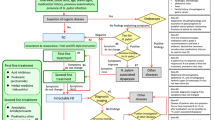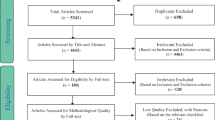Abstract
Background
Sennosides are commonly used for the treatment of constipation and associated with melanosis coli. In the present study, we evaluated the utility of melanosis coli as a marker of severity and its association with colonic motility in children with functional constipation.
Methods
Prospective study includes pediatric patients undergoing colonic manometry and colonic biopsies. Demographic data, medication history, surgical history, colonic manometry results (gastrocolonic response to a meal, high-amplitude propagating contractions, and nonpropagating contractions), colonic manometry catheter position, and pathologic results were collected and analyzed. We compared those variables with outcome (need for surgery) between both patient groups (presence or absence of melanosis coli).
Results
A total of 150 patients were included, median age was 9.9 years (range 2.1–18) and 77 (51.3%) were female, 17 had melanosis. Patients who took sennosides had higher rates of melanosis coli compared to those who did not (adjusted OR 13.88; 95% CI 4.05–47.57; P < 0.001), and we did not find an association between melanosis coli and use of other medications (osmotic laxatives, bisacodyl, lubiprostone), age, gender, weight, and height. We found no significant difference in the results colonic manometry between patients with and without melanosis coli. The rates of surgery for constipation between patients with and without melanosis coli were not statistically different. (OR 3.00; 95% CI 0.45–20.07; P = 0.257).
Conclusions
Melanosis coli is associated with sennosides use, but it does not influence colonic motility nor is associated with increased subsequent need for surgery in pediatric functional constipation.

Similar content being viewed by others
References
Wang S, Wang Z, Peng L, Zhang X, Li J, Yang Y et al. Gender, age, and concomitant diseases of melanosis coli in China: a multicenter study of 6090 cases. PeerJ 2018;6:e4483.
Nesheiwat Z, Al Nasser Y. Melanosis Coli. In: StatPearls. Treasure Island, FL: StatPearls Publishing; 2021.
Li D, Browne LW, Ladabaum U. Melanosis coli. Clinical Gastroenterology and Hepatology: The Official Clinical Practice Journal of the American Gastroenterological Association 2009;7:A20.
Bechara R, Marcon N, Streutker CJ. Melanosis coli: a disappearing act. Gastrointestinal Endoscopy 2016;83:1296–1298.
Rutty GN, Shaw PA. Melanosis of the appendix: prevalence, distribution and review of the pathogenesis of 47 cases. Histopathology 1997;30:319–323.
Koskela E, Kulju T, Collan Y. Melanosis coli. Prevalence, distribution, and histologic features in 200 consecutive autopsies at Kuopio University Central Hospital. Diseases of the Colon and Rectum 1989;32:235–239.
Joo JS, Ehrenpreis ED, Gonzalez L, Kaye M, Breno S, Wexner SD et al. Alterations in colonic anatomy induced by chronic stimulant laxatives: the cathartic colon revisited. Journal of Clinical Gastroenterology 1998;26:283–286.
Rodriguez L, Sood M, Di Lorenzo C, Saps M. An ANMS-NASPGHAN consensus document on anorectal and colonic manometry in children. Neurogastroenterology and Motility: The Official Journal of the European Gastrointestinal Motility Society 2017;29:e12944.
Di Lorenzo C, Flores AF, Reddy SN, Hyman PE. Use of colonic manometry to differentiate causes of intractable constipation in children. The Journal of Pediatrics 1992;120:690–695.
Modi RM, Hussan H. Melanosis coli after long-term ingestion of cape aloe. ACG Case Reports Journal 2016;3:e157.
Esteban Jimenez O, Navarro Peman C, Gonzalez Rubio F, Carmen Malo Aznar M. Melanosis coli due to diacerein. Gastroenterologia y Hepatologia 2017;40:93–95.
Liu L, Gao H, Yu W, Zhang S, Guo J, Zhu K. Outcome analyses of 15,189 screenings Via colonoscopy. Surgical Laparoscopy, Endoscopy & Percutaneous Techniques 2017;27:400–403.
Higgins PD, Johanson JF. Epidemiology of constipation in North America: a systematic review. The American Journal of Gastroenterology 2004;99:750–759.
Harris A, Buchanan GN. Melanosis coli is reversible. Colorectal Disease: The Official Journal of the Association of Coloproctology of Great Britain and Ireland 2009;11:788–789.
Yang N, Ruan M, ** S. Melanosis coli: a comprehensive review. Gastroenterol Hepatologia 2020;43:266–272.
Freeman HJ. “Melanosis” in the small and large intestine. World Journal of Gastroenterology 2008;14:4296–4299.
Dinning PG, Wiklendt L, Maslen L, Gibbins I, Patton V, Arkwright JW et al. Quantification of in vivo colonic motor patterns in healthy humans before and after a meal revealed by high-resolution fiber-optic manometry. Neurogastroenterology and Motility: The Official Journal of the European Gastrointestinal Motility Society 2014;26:1443–1457.
Bharucha AE. High amplitude propagated contractions. Neurogastroenterol Motility 2012;24:977–982.
Cook IJ, Furukawa Y, Panagopoulos V, Collins PJ, Dent J. Relationships between spatial patterns of colonic pressure and individual movements of content. American Journal of Physiology Gastrointestinal and Liver Physiology 2000;278:G329–G341.
Rodriguez L, Siddiqui A, Nurko S. Internal anal sphincter relaxation associated with bisacodyl-induced colonic high amplitude propagating contractions in children with constipation: a colo-anal reflex? Neurogastroenterol Motility 2012;24:1023.
Wessel S, Koppen IJ, Wiklendt L, Costa M, Benninga MA, Dinning PG. Characterizing colonic motility in children with chronic intractable constipation: a look beyond high-amplitude propagating sequences. Neurogastroenterology and Motility: The Official Journal of the European Gastrointestinal Motility Society 2016;28:743–757.
Malik AH, Andrabi SI, Niayesh M. Pseudo-obstruction with pitch black colon–a very rare presentation of melanosis coli. The Ulster Medical Journal 2008;77:54–55.
Badiali D, Marcheggiano A, Pallone F, Paoluzi P, Bausano G, Iannoni C et al. Melanosis of the rectum in patients with chronic constipation. Diseases of the Colon and Rectum 1985;28:241–245.
Villanacci V, Bassotti G, Cathomas G, Maurer CA, Di Fabio F, Fisogni S et al. Is pseudomelanosis coli a marker of colonic neuropathy in severely constipated patients? Histopathology 2006;49:132–137.
Levitt MA, Mathis KL, Pemberton JH. Surgical treatment for constipation in children and adults. Best Practice & Research Clinical Gastroenterology 2011;25:167–179.
Funding
None.
Author information
Authors and Affiliations
Contributions
JJC participated in the study design, data analysis, manuscript drafting and approval. KC participated in the study design, data collection and analysis, manuscript drafting and approvals. SN participated in the study design, data collection, manuscript drafting and approval. LR participated in the study design, data collection and analysis, manuscript drafting and approval.
Corresponding author
Ethics declarations
Conflict of interest
The authors disclosed no conflicts of interest.
Additional information
Publisher's Note
Springer Nature remains neutral with regard to jurisdictional claims in published maps and institutional affiliations.
Rights and permissions
About this article
Cite this article
Chen, JJ., Kitzia Colliard, R.N., Nurko, S. et al. Melanosis Coli Is Not Associated with Colonic Dysmotility Nor Severity of Pediatric Functional Constipation. Dig Dis Sci 67, 3922–3928 (2022). https://doi.org/10.1007/s10620-021-07191-z
Received:
Accepted:
Published:
Issue Date:
DOI: https://doi.org/10.1007/s10620-021-07191-z




